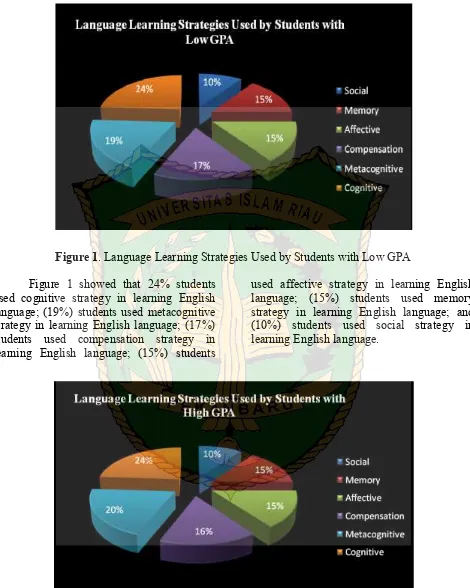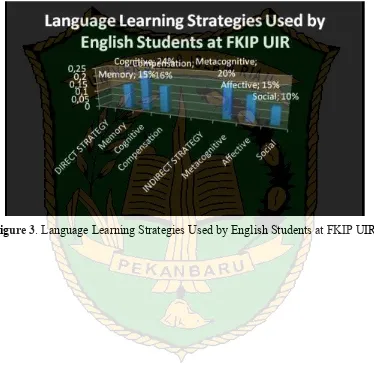146 LANGUAGE LEARNING STRATEGIES USED BY ENGLISH STUDENTS AT FKIP UIR
(Strategi Pembelajaran Bahasa yang Digunakan Mahasiswa Program Studi Pendidikan Bahasa Inggris di FKIP UIR)
Oleh: Miranti Eka Putri*)
*) Dosen FKIP Universitas Islam Riau
ABSTRAK
Kajian ini dilaksanakan bertujuan untuk mengetahui dan menganalisa strategi pembelajaran mahasiswa terhadap pembelajaran Bahasa Inggris di FKIP UIR. Strategi pembelajaran bahasa terdiri dari enam strategi, yaitu: memori strategi, kognitif strategi, kompensasi strategi, metakognitif strategi, afektif strategi, dan sosial strategi. Kajian deskriptif ini dilakukan di FKIP UIR dengan menggunakan data kuisioner dan data dokumen. Kuisioner dan dokumen telah dilaksanakan kepada 224 mahasiswa program studi pendidikan bahasa Inggris pada semester VII. Hasil kajian ini menunjukan bahwa mahasiswa yang memiliki IPK tinggi cenderung menggunakan strategi metakognitif dan mahasiswa yang memiliki IPK rendah cenderung menggunakan strategi kognitif dalam pembelajaran bahasa Inggris. Dilihat secara khusus, didapati bahwa mahasiswa yang memiliki IPK rendah cenderung menggunakan sosial strategi 10% (18,94); afektif strategi 15% (27,62); memori strategi 15% (27,20); kompensasi strategi 17% (30,23); metakognitif 19% (35,55); dan kognitif 24% (43,05). Selanjutnya didapati bahwa mahasiswa yang memiliki IPK tinggi cenderung menggunakan sosial strategi 10% (4,72); afektif strategi 15% (31,21); memori strategi 15% (31,34); kompensasi strategi 16% (33,57); metakognitif 20% (40,73); dan kognitif 24% (48,87).. Hasil analisis kajian ini juga mendapati bahwa mahasiswa cenderung menggunakan kognitif strategi dalam pembelajaran bahasa. Sehingga didapati bahwa strategi pembelajaran bahasa merupakan faktor yang signifikan dalam menentukan pemahaman dalam pembelajaran bahasa.
Kata Kunci: Language Learning Strategies, Grade Point Average (GPA)
INTRODUCTION
Language learning strategies are part of a larger system included in the process of learning a second or foreign language in the classroom. They have been a primary concern on the researchers, and they have been one of the most fertile areas of research in the area of second of foreign language learning (Maclntyre, 1994). Language learning strategies deal with the ways how language learner process receive new information, and how they express their ideas or feelings. Kinds of language learning strategies used by learners depend on several variables either coming from inside or outside of the learners. The use of language teaching approaches or methods claimed to give an impact on the kinds of language learning strategies used by learners (Oxfford and Nyikos,1989) because
stated that there were two strategies in language learning direct strategy and indirect strategy. Direct strategies deals with the new language, which consists of three classes; memory strategy, cognitive strategy and compensation strategy. Indirect strategy was strategy that support and manage language learning without directly involving in the target language. Indirect strategy was divided into metacognitive strategy, affective strategy, and social strategy.
RESEARCH METHODHOLOGY
The population of research was 224 students of semester eighth at FKIP UIR and using totally sampling. The students with low GPA were 86 students and students with high GPA were 138 students.. Questionnaire and documentation were used as instruments. There
was sixty two items in the questionnaire conducted by using six component in language learning strategies and students’ KHS as document. The students devided into two categories, there were low GPA and high GPA. Students with high GPA was 3,00 – 4,00 (very satisfying and with honor) while students low GPA was 2,25 – 2,99 (satisfactory). The results of the study were analyzed by using descriptive quantitative data:
Research Question #1:
What are language learning strategies used by English students with low GPA at FKIP UIR? Research Question #2:
What are language learning strategies used by English students with high GPA at FKIP UIR?
153 FINDINGS
Figure 1. Language Learning Strategies Used by Students with Low GPA Figure 1 showed that 24% students
used cognitive strategy in learning English language; (19%) students used metacognitive strategy in learning English language; (17%) students used compensation strategy in learning English language; (15%) students
used affective strategy in learning English language; (15%) students used memory strategy in learning English language; and (10%) students used social strategy in learning English language.
Figure 2. Language Learning Strategies Used by Students with Low GPA
Figure 2 showed that, 24% students used cognitive strategy in learning English
language; (20%) students used metacognitive strategy in learning English language; (16%)
students used compensation strategy in learning English language; (15%) students used affective strategy in learning English language; (15%) students used memory strategy in learning English language; and (10%) students used social strategy in learning English language.
Figure 3 showed that, 24% students used cognitive strategy in learning English language; (20%) students used metacognitive strategy in learning English language; (16%)
students used compensation strategy in learning English language; (15%) students used affective strategy in learning English language; (15%) students used memory strategy in learning English language; and (10%) students used social strategy in learning English language. In conclusion, English students of eight semester at FKIP UIR (65%) used direct strategy in language learning and (45%) used direct strategy in language learning
Figure 3. Language Learning Strategies Used by English Students at FKIP UIR
153 DISCUSSION
Cognitive strategy was dominant used by students with high and low GPA in learning English language, example they use taking note, summarizing and highlighting in learning language because they deal with the actual processes involved in manipulating the language for reception and production of meanings. It allowed the learners to better comprehend and produce language in different manners, such as, four sets of learning strategies, practicing, receiving and sending messages, analyzing and reasoning, and creating structure for input and output and each set further encompasses some subsets of more practical learning strategies. Practicing strategies cover five subsets of strategies; repeating, formally practicing with sounds and writing system, recognizing and using formulas and patterns, recombining, and practicing. There are two kinds of strategies are useful for receiving and sending messages in application; getting the idea quickly, and using resources for receiving and sending messages. There are five kinds of strategies are useful for Analyzing and reasoning: reasoning deductively, analyzing expressions, analyzing contrastively (across languages), translating, and transferring. There are three kinds of strategies are useful for creating structure for input and output: taking notes, summarizing, and highlighting.
Secondly, metacognitive strategy was behavior that involve thinking about learning process such as centering the learning ,arranging and planning the learning , monitoring the learning tasks and evaluating how
well one has learned. For example, the students plan ,monitor, hypotysize about and evaluate the performance of learning task. Therefore, by possessing these strategies, the learners would be able to determine what their learning objective, to monitor their understanding about materials being learned and to evaluate what they have learned how well they have done it. The category of strategies are diveded into three sets of strategies; centering the learning, arranging and planning the learning, and evaluating, and each sets has two or more subsets of strategies.
Thirdly, compensation strategies, these allowed the learners to use the certain skills to compensate their lack of other skills for the purpose of being able to comprehend the input or to express ideas. The language learners used their syntactical knowledge, such as using their ideas in learning language. Compensation strategies is divided into two; guessing intelligently and overcoming limitations in speaking and writing. In area of application, guessing intelligently involves; using linguistic clues and using other clues. While overcoming limitation involves; switching to the mother tongue, getting help, using mime or gesture, avoiding communication partially, selecting the topic, adjusting or approximating the message, coining words, and using a circumlocution or synonym.
Fourthly, affective strategy are used for controlling emotions, attitudes, and motivation that influence the success the failure of language learning. Affective strategies are very important in language learning because they may help the learners to control their emotions, to possess positive attitudes toward the target
language and to generate strong motivation. Some researchers found that many second or foreign language learners failed to master the target language because they did not know how to control their emotions and how to build up positive attitudes towards learning and how to generate and increase their motivation to learn a second or foreign language. Three sets of strategies are included in this group: Lowering Anxiety, Self-Encouraging, and Taking Emotional Temperature. In the application, lowering anxiety includes; using progressive relaxation,deep breathing,or meditation, using music, and using laughter. Self-encouraging involves; making positive statement, taking risk wisely, and self-rewarding. While taking emotional temperature includes; listening to body, using a checklist, writing a language learning diary, and discussing your feeling with someone else.
Next, Memory strategies comprise four sets of learning strategies , creating mental linkages, applying images and sounds, reviewing well and employing actions and each set further encompasses some subsets of more practical learning strategies. Creating mental linkage strategies cover three subsets of strategies , applying images and sounds strategies cover four subsets of strategies, reviewing well strategies cover one subset of strategies, and employing actions strategies cover two subsets of strategies. There are three kinds of strategies are useful for making mental linkages in application; grouping, associating/elaborating, and placing new words into context. Grouping involves classifying or reclassification what is heard or read into meaningful groups, thus reducing the number of related elements.
Last, Social strategy is a strategy that involves other people in the process of language learning. Social strategies help students learn through interaction with others. Social strategy makes it possible to create a better interaction between learners, between learners and teachers or between students and other users of the target language. This strategy is necessary in the process of language learning because they involve other people. Social strategy includes three sets of learning strategies, ask questions, cooperate with others and empathize with others. Social strategies are very important in learning a language because language is used in communication and communication occurs between people. Three sets of strategies are included in this group: Asking Questions, Cooperating with others, and empathizing with others. In application, asking question includes; asking for clarification or verification and asking for correction. Cooperating with others includes; cooperating with peers and cooperating whit proficient users of the new language. And empathizing with others includes; developing culture understanding and becoming aware of other‘s thoughts and feeling.
155 Since cognitive strategies allowed the
learners to better comprehend and produce language in different manners. Meanwhile, metacognitive strategy help them to plan language learning in an efficient way. When new vocabulary, rules, and writing system confuse the learners, these strategies become vital for successful language learning
RECOMMENDATION
Students should be exposed to the benefits and knowledge of using language learning strategies in learning English language. It is expected that this increase students’ skill in English language. The positive students’ in learning Engliah language based on language learning strategies was a good indicator to measure their confidence to learn English language. High level of students’ GPA will maintain the implementation of language learning strategies and assure students’ in learning english language. Lack of six language learning strategies in learning English language, cognitive strategy, metacognitive strategy, compensation strategy, affective strategy, memory strategy, social strategy in learning English language could be an obstacle in using language learning strategies. Students should provide some information to use use language learning strategies.
REFERENCES
Buku Panduan Akademik. 2007. Pekanbaru: FKIP UIR
Brown, H.D. 1980. Principles of Language Learning & Teaching (First Edition). Englewood Cliffs: Prentice Hall, Inc. Introduction to Theories of
Learning (2nd ed.).
Englewood Cliffs: Prentice Hall Inc.
Malone, J.1990. Theories of
learning: a historical
approach. Belmont:
Wadsworth Publishing Company.
O‘Malley, J. M., & Chamot, A.U. 1990. Learning strategies in
second language
acquisition.‖ Cambridge: Cambridge University Press.
Oxford, R.L. 1989. Language Learning Strategies: What
Every Teacher Should
Know. New York: Newbury House Publishers.
Oxford, R. L. 1990. Language learning strategies: What every teacher should know. Boston, MA: Heinle & Heinle Publishers.
Oxford, R. L., and Nyikos, M. 1989. Variables affective choice of
language learning
strategies by university
students. Cambridge:
Cambridge University Press.
Rigney, J. W. 1978. Learning strategies: A theoretical perspective. In H. F.
159

